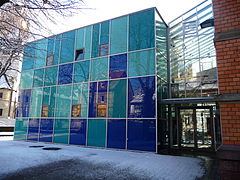Window
![]()
The title of this article is ambiguous. For other meanings, see Window (disambiguation).
![]()
This article or section is still missing the following important information:
The article is unfortunately quite technology-heavy and presents the window with virtually no context. The architectural perspective is missing: where in the building are which and how many windows installed in which configuration and why? What role does window placement play in different building styles? Why do different building forms (homes, supermarkets, churches, schools, art museums) require different window arrangements? How are different climatic, geographical (light conditions!) and cultural conditions taken into account?
Help Wikipedia by researching and adding them.
In the building industry, a window is a light opening in a wall or in the roof of a structure, as well as its wind- and weatherproof closure. Windows are used for illumination, ventilation and view. Furthermore, windows are one of the main elements of the aesthetic division of the facade and ideally decorate both the exterior and the interior of the house.
Windows today usually consist of a frame and the glass window panel. The frame is inserted into an opening in a wall or the roof. The wall opening is usually reinforced at the top by an arch or by a lintel, at the sides by the reveal or the flaps and at the bottom by the sill. Often a movable sash allows ventilation of the interior. Windows are traditionally manufactured and installed by glaziers, carpenters and specialized window manufacturers.
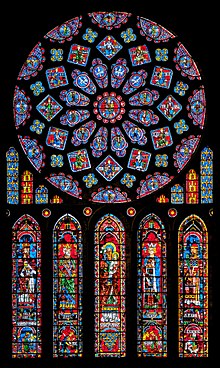
Gothic stained glass, c. 1230-1235, in Chartres Cathedral
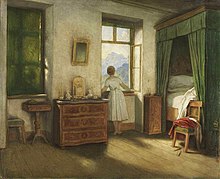
Main functions of the window: illumination, ventilation, view, wall division (Moritz von Schwind: Morgenstunde)
Term
The term "window" is used to describe openings enclosed on all sides in the outer boundaries of structures with the purpose of allowing visual contact between the inside and outside and/or the incidence of light. The main use of the German term is in the building industry. According to the definition in sheet 1 of VDI 4700, windows are used for lighting and usually also for ventilation. In distinction to the door or gate, the window lacks the function of the passage or entrance. Furthermore, windows are used in the casings of vehicles, in plant construction and in other technical equipment. In the aforementioned fields, windows can be mere openings, but they are usually filled with glass or other translucent materials. They can be fixed or have constructive devices for opening. Figuratively, "windows" also refer to other types of narrowly circumscribed passageways in otherwise impermeable structures. In computing, so-called "windows" are a fundamental element of graphical user interfaces; they gave the Microsoft operating system Windows its name.
Etymology
The noun window has been part of the standard German vocabulary since the 8th century. It is borrowed from the Latin fenestra, whose origin is obscure. The neutral genus probably comes from the older ouagtora for "eye gate" (round window). The Old Germanic term for it meant wind-eye (Gothic windauga), which survives in the Danish term vindue and in English window.
History
Window crowns or rows of windows already existed in the basilicas or the thermae of antiquity; however, with the exception of the - later modified - Constantine Basilica in Trier (4th century), none of them have survived. In early and high medieval church buildings, rows of uniform windows are regularly found. The most important building with a preserved row of windows is the Hagia Sophia (6th century) in Constantinople/Istanbul. In medieval architecture they sometimes appear on choir ambulatories, on apses or in lantern towers.
Pre-Glass Age
The oldest human dwellings or cult buildings (e.g. Göbekli Tepe) were windowless; sources of light were the entrance and the smoke outlet in the roof. Neolithic houses already had slit-like light openings. In Persepolis, window openings were found in the mud wall of a 6000-year-old house. Even the residential and cult buildings of the Egyptians as well as the Greeks and Romans were largely windowless on the outside; windows were probably found mainly in royal and market halls (basilicae) as well as in thermal baths. In northern Europe, shutter-like window closures are known from the Neolithic and the Bronze Age. Also urns of different origin are designed in the form of buildings with windows (house urn).
Originally, windows were rectangular, arched, round or oval openings in walls, which in a later phase were covered with skins, parchment or linen cloth to reduce the effects of weathering. Thin, translucent alabaster was also used in wall openings, mainly in sacred buildings. Since the Romanesque period, there have also been trefoil or fan-shaped windows (e.g. Quirinus Minster in Neuss). The largest (preserved) Romanesque windows are the west windows of the cathedrals of Chartres and Le Mans, which are provided with iron struts; in the Gothic period, they are the windows of the English cathedrals stabilized by bar and tracery or the huge transept windows of the cathedral of Metz; the west window of the Altenberg Cathedral should also be mentioned in this context.
Beginning of the glass age
First window glasses were found in Aix-en-Provence and Herculaneum. The finds have sizes of up to 80 cm². However, no written tradition mentions the manufacturing process. For the early, thick-walled and one-sided frosted window glass, there are different opinions among experts about its production. On the one hand, a manual stretching technique is assumed. The Romans had been using glass since the 1st century BC at the latest. Initially, the panes were rough on one side and therefore not transparent. It was not until the 2nd century AD that glass appeared that had a smooth surface on both sides. At least north of the Alps, however, window glass was only used sporadically, for example in churches from the 5th century onwards. It was not used more widely until the 12th century, when it was occasionally found in private houses as a special luxury. Even in the 15th century, however, it was by no means a matter of course in cities.
Window glass is also used as a substrate for stained glass or is stained to create ornamental glass and glass mosaics. Since the Gothic period, this technique has been used to design church windows, and later also windows on secular buildings. The production of large glass panels has only been possible since industrialisation. For this reason, window panes were assembled from several smaller pieces of glass for centuries.
Gründerzeit
In residential buildings, wooden windows in double box construction were mostly used. Industrial and other commercial buildings were either fitted with wooden windows or windows made of cast iron. Regionally, the same standard dimensions were used. Following the Gründerzeit, the 20th century began with various architectural trends that tried out new forms of design. In New Building, as in the more traditional style of the 1920s and 1930s, the façade openings were increasingly combined into window bands.
New Objectivity
In residential buildings, wooden windows were mostly used as composite windows. Industrial and other commercial buildings were fitted with either wooden windows or windows made of steel profiles. Windows were industrially manufactured with standard dimensions and modules, e.g. the Frankfurt standards of the New Frankfurt. Installation of the sliding window, which was uncommon in Europe until then.
1950s
Economic Miracle
In residential buildings, wooden windows in double box construction were mostly used. Industrial and other commercial buildings were equipped with either wooden windows or windows made of steel profiles. Windows were manufactured with standard dimensions and modules in industrial production. Installation of the sliding window, unusual in Europe.
1954: Development of the first plastic window
Heinz Pasche developed the first plastic window together with the company Dynamit Nobel from Troisdorf. Pasche was a metalworker and wanted a plastic coating over a metal frame that was weatherproof and insensitive. At that time, Dynamit Nobel was already known for its developments in the plastics market and had various extruders at its disposal. This then gave rise to the Trocal company, which brought the first plastic window onto the market in series production in 1954.
· 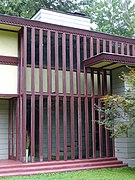
Row of windows in Frank Lloyd Wright's Louis Penfield House (1955)
· 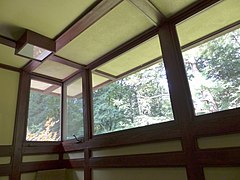
Frank Lloyd Wright has led window bands around corners many times (Louis Penfield House)
· 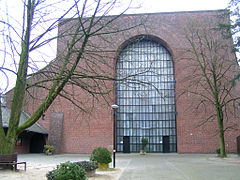
Largest wooden window in Europe at St. Elisabeth, Opladen 1957
1970s and 1980s
In residential buildings, wooden, aluminium and plastic windows were used as single windows with double glazing (e.g.: 4-12-4). Industrial and other commercial buildings used wood, aluminum, steel, and vinyl windows. Windows were industrially manufactured with standard sizes and modules. Prevalence of vinyl windows.
1990s until today
The window systems differ relatively strongly in the individual countries, in the following windows for the central part of Europe are described:
From the mid-1980s, insulating glass windows - single windows with 2-pane insulating glazing and a tilt and turn fitting - clearly dominate in Germany. The thermal insulation of the glass is significantly increased by metal vapour deposition on one of the two panes. Plastic windows are gaining strong market shares. In turn, wooden windows are faced on the outside with aluminium frames in order to achieve the necessary weather protection. From the beginning of the 2000s, triple-glazed insulating windows with increasingly better thermal insulation are built, the thermal insulation of windows is increased and enables the construction of low-energy and passive houses. Window elements are used extensively in both residential and commercial buildings, and the proportion of glass in the external surface area is increasing sharply.
Until about 1990, large windows with insulating glazing or thermal insulation glazing for buildings could only be manufactured as flat panes. Further developed manufacturing processes in the glass industry now also allowed curved panes, as is common in automotive construction. Windows are no longer purely wall openings, but are viewed in terms of building construction as modularised facades. Manufacturing specifications, static conditions, function and building standards have to be taken into account. The basis for a new window is usually modular systems, i.e. the window profiles and accessories have already been tested and matched to each other, they are only brought to the correct length and assembled.
Modern buildings such as the Sony Center in Berlin are often referred to as "element facades", as windows are mounted directly onto windows. Occasionally, horizontally lined-up windows are also referred to as "ribbon windows" or "ribbon windows".
· 
Window facade at the Sony Center in Berlin
·
Extension of the Tiefburg School in Heidelberg-Handschuhsheim
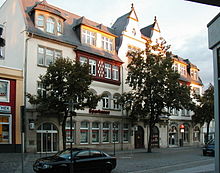
Wilhelminian style facade with a particularly large number of different windows, Radebeul 1902
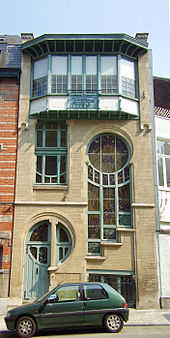
Muntin windows of the Art nouveau: L'atelier du maître-verrier Sterner 1904, Brussels
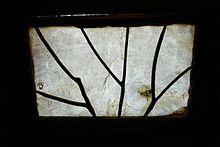
Window with animal skin covering, Celtic Museum Mitterkirchen/Upper Austria
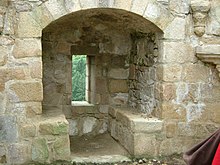
Typical medieval "window niche" with stone lintel: recognizable are stone lintel made of cleanly smoothed ashlar in the quarry stone masonry, stone window sill and heavy window lintel, and a rabbet to fasten the window closure.
Search within the encyclopedia
